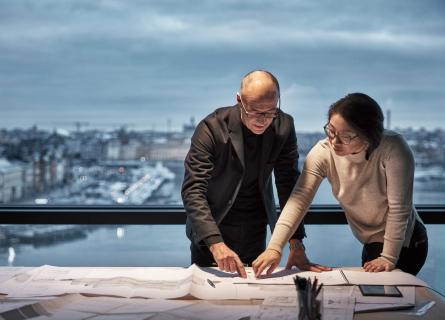
A successful circular economy business park requires collaboration and open communication
At best, a regional circular economy business park benefits both the companies operating in the area as well as the local municipality, and it can contribute to achieving the climate and circular economy targets of both.
Circular economy business parks are communities or ecosystems of companies operating in a symbiotic business relationship. In such a relationship, the companies can make use of each other’s surplus energy or materials in their operations, or they can have other types of resource or knowledge sharing.
This allows them to increase their resource and service efficiency, for example by purchasing local facility management or transportation services as a group/community.
The development of a circular economy business park requires time and efforts, thus it is a good idea to learn from the existing parks that have succeeded and to apply their methods and good practices
Circular economy business parks’ success factors
The optimal operation of a circular economy business park requires interaction based on openness and trust especially between companies who benefit from close-range operation. In addition, functional infrastructure in the area is needed. Furthermore, developing a business model as well as an operating model that work for both the particular region and the participating companies are important.
The importance of openness and trust shall not be undermined. Circular economy-based business differs from conventional linear business by placing even more emphasis on collaboration. When trust can be established, companies commit stronger to working together and contribute to developing respective operations, for example by establishing new symbiotic relationships. The transparency of operations will increase trust among the companies. Transparency and trust can be developed, for example, by inviting local companies to participate in the development process of the park.
It might be challenging to find potential companies and other partners for the park, as collaborative business is yet not a norm in the society. The initial spark will require a regional business model and a leader. The business model will determine who are to make the decisions regarding the park. The coordinator creates a network of the interested companies and the ideas for industrial symbioses for the region is developed together.
The leader’s role is critical for the success of the park because without a leader the development will be slow or non-existent. For example, there was a time when the circular economy park of Händelö, Sweden, had no leader. In the absence of a leader, the circular economy park was kept alive thanks to the existing symbioses and material flows, but it could not grow to its full potential. It is the important task of the leader to monitor, develop and steer the region’s operations onward.
Creating and maintaining a circular economy ecosystem takes plenty of time and resources, and a successful circular economy business park will not be created in an instant. Companies will demand synergy benefits in exchange for contributing to the park. Mapping these benefits will require encounters and dialogue. Potential synergies can be explored in joint workshops, for example, where companies present their needs as well as the services and materials they can offer to the circular economy.
Once the idea has been established and the symbiosis works on paper, it can be tested in practice as a development project. Short- and longer-term projects will help companies to commit to the park. All short-term projects are to serve a longer-term objective, such as utilizing a by-product material flow. For example, there was a project-based development in the Kalundborg industrial area in Denmark, where each symbiosis was developed as a separate project.
Other proven success prerequisites include close-by locations, an even and sufficiently large amount of symbiotic material or energy flows, and business diversity in the region.

Development of regional circular ecosystem
The development of a circular economy ecosystem is affected by the existing activity in the region as well as the original business structure; for example, whether the economy is growing around an industry or a recycling center. In the Finnish Ministry of Economic Affairs and Employment’s publication about ecosystems in circular economy (2020:13), ecosystems were divided into three categories: those that rely on regional strengths, those that rely on a circular economy vision, and those that are strong drivers of industry. Physical regional circular economy parks, too, can be classified into types of ecosystems, and after identifying the type, the growth of the region can be supported with targeted actions.
Business potential evaluation
Assessment of the current situation is the first phase of the development process. What kinds of material and energy flows exist in the region? How substantial are they? Which companies already operate in the region? This assessment of material and energy flows can be done both in cooperation with the companies and/or with the help of existing publicly available statistics. For example, the National Industrial Symbiosis Program (NISP) originating in the UK has proven to be simple but effective. NISP has organized regional workshops to find symbioses for the utilization of waste and side streams and for the procurement of raw materials and energy.
Once the current situation, suitable resource streams and needs are found, the development can move on to business potential evaluation. Once the qualities and quantities of the material and energy flows are known, their uses can be envisioned. Obviously from the point of view of loss avoidance. In addition to the current resource flows in the area, business potential evaluation includes also possible new businesses in the area possibly utilising the circular business models.
Land use and planning/zoning
Once the potential and vision for a regional circular economy park have been laid out, it is time to plan land use. Regarding land use, it is important to analyse the current situation in the region. It is necessary to learn about the land-use planning and zoning situation as well as land-use restrictions that may affect how operations are located in the area. Factors influencing the further development of the region may include land ownership, existing transport connections, and various conservation and/or investment sites. The soil type of the region may also affect the development of a physical circular economy park.
Land-use planning includes studying what kind of operations are suitable for the region, and what locating them in the region will require in terms of infrastructure, for example. The circular economy vision is further refined when planning the placement of different operations. The purpose of location planning is to enable the establishment of business synergies and service chains.
The objective of land-use planning is to obtain an overall idea of the region’s future so that the space needed for the operations envisioned, their respective locations, and the infrastructure required for the development, including energy and water supply, as well as traffic and transportation can be coordinated to form a functional package. Although studies have stated that closely located companies in a circular economy park are more successful and able to develop synergies, in practice companies’ offices can also be located outside the area considered to constitute the park.
The services necessary for the park can be determined in cooperation with the participating companies, for example regarding transport, weighing, maintenance, laboratory or restaurant services. Shared services will create cost savings, and their utilization rate as well as that of the necessary infrastructure will be better.

In summary: What makes a successful circular economy business park?
In a successful circular economy business park, companies collaborate, the park’s operations are well communicated, particularly internally, and the park is profitable, constantly developing and attractive to companies. A successful circular economy business park has a leader, who manages, develops and steers its operations towards a successful future. Land use in the park is well planned and enables the creation of new symbioses and the development of the participating businesses. The park could develop or have developed independently, but the leader plays an essential role in achieving its full potential.
We must remember that organically developed circular economy business parks, such as the textbook example Kalundborg, have developed over many decades into what they are now. We can learn from the existing parks and use their prerequisites for success as a guideline to apply when developing a new park. In order to develop a financially stable circular economy business park, it is important to study the region’s potential and consistently steer the region’s operations towards its organic growth potential
This article was originally published in Finnish in the Ympäristö ja Terveys magazine’s November 2021 issue.



